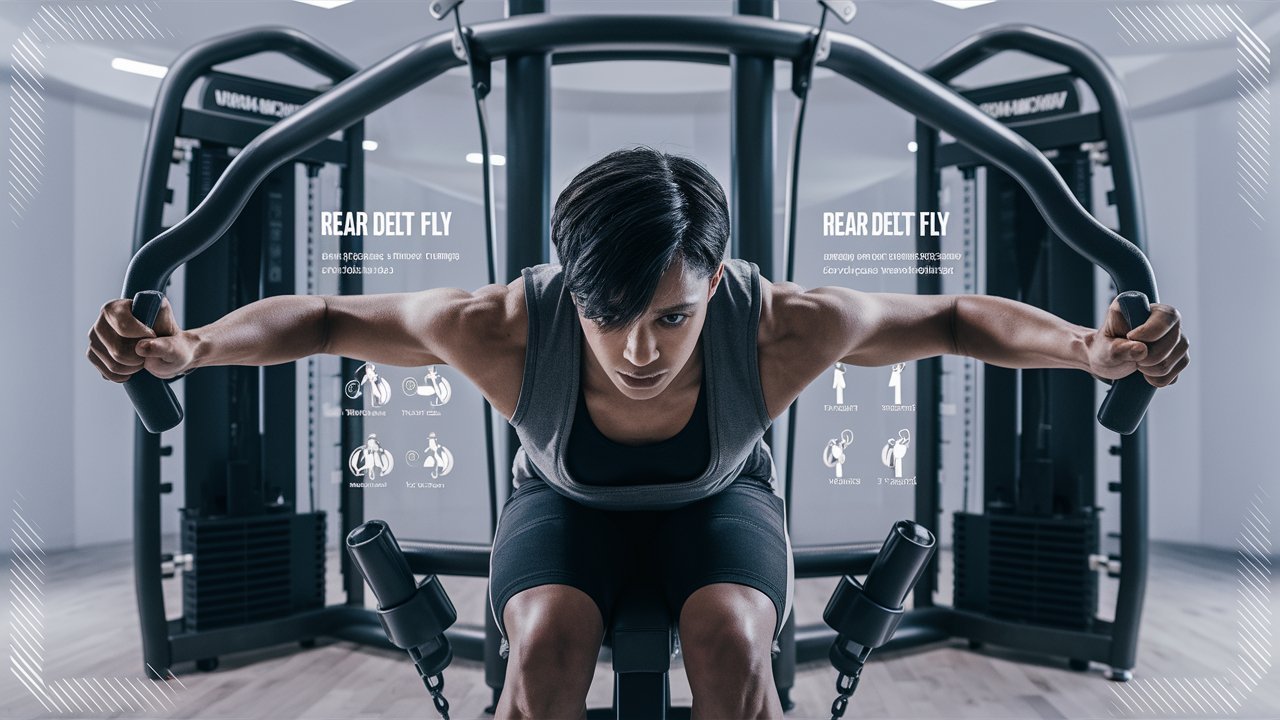How to Do Rear Delt Fly Machine

What is the rear delt fly machine?
The rear delt fly machine, also known as the rear delt machine, is a piece of exercise equipment that isolates and targets the rear deltoid muscles. The rear deltoids also called the posterior deltoids, are located at the back of the shoulders. They are responsible for shoulder extension and horizontal abduction movements. The rear delt fly machine allows you to work these muscles through a controlled range of motion to help build strength and size.
Muscles worked
As the name implies, the primary muscles targeted during a rear delt fly exercise on the machine are the rear deltoids. However, some secondary muscle activation also occurs in:
- Teres minor: This is a small muscle located deep in the back of the shoulder joint. It assists with shoulder external rotation.
- Rhomboids: Two muscles located between the shoulder blades that help draw the scapulae (shoulder blades) together.
- Trapezius: This is the large, diamond-shaped muscle covering the back of the neck and shoulders. The middle fibers are engaged during rear delt flies.
In summary, while focusing on building the rear deltoids, secondary muscle involvement will add additional back thickness and shoulder strength.
Basic setup
To properly perform rear delt flyes on the machine:
- Adjust the seat height so your shoulders are level with the pads when seated. You want a comfortable position without straining your lower back.
- Grip the handles and sit upright with your spine straight and chest up. Don’t round your shoulders forward.
- Position your upper arms against the pads to remain stationary throughout the movement.
- Keep tension on the muscles, and don’t allow your body to swing during the motion.
- Contract your shoulder blades together by imagining you’re trying to pinch a pencil between them. This engages the rear delts.
Performing the exercise
Once set up correctly on the machine, perform the exercise as follows:
- Start with your arms bent so your hands are beside your torso, elbows tucked close to your sides.
- Inhale and exhale as you slowly raise the handles to your sides by externally rotating your shoulders. Imagine you’re opening a pair of wings.
- Pause for a second at the top when your arms are parallel to the floor. Squeeze your rear delts.
- Inhale and return under control to the starting position in a slight arc. Don’t swing or jerk the weight.
- Repeat for your desired number of repetitions. Maintain control throughout the lift.
- When finished, either lower the weight pin one increment, release the handles, and scoot from under the pads. Wipe down when done.
Tips for better form
Here are some additional tips to focus on for optimal form:
- Keep your body still – Avoid swaying or moving your torso during the lift. This shifts focus away from the targeted muscles.
- Control the weight: Lift it with control on the way up and lower it slowly back down. Don’t use momentum from swinging.
- Squeeze at the top – Pause at the top for a second and contract your rear delts before lowering.
- Limit swinging – Keep your arms hugging close to your body as you lift to limit swinging motions.
- Retract shoulder blades – Actively pinch your shoulder blades together throughout for optimal contraction of the rear delts.
- Breathe properly – Inhale on the way down and exhale as you lift the weight up.
- Adjust weight as needed – Start lighter and focus on form. Increase weight gradually as muscles accommodate the load.
- Use a full rep range: Take the motion through a full yet controlled range, from hands at sides to parallel with the floor.
Following these form tips will maximize muscle recruitment in the targeted rear delts and minimize the risk of injury. Proper form is key for safe and effective results.
Sets and reps
When first learning the movement, start with lighter weight and focus on perfecting form through the full rep range. In general, here are some guidelines for sets and reps on the rear delt fly machine:
- For hypertrophy (muscle size): 3-4 sets of 8-12 reps
- For strength: 4 sets of 4-6 reps
- For toning: 3 sets of 15-20 reps
Increase weight gradually over time as your strength improves so that you can continue challenging the muscles. You can also vary rep ranges from workout to workout for continual advancement.
Listen to your body as well – if joints or connective tissues feel stressed, reduce weight or volume temporarily until recovered. Consistency in training with quality form is more important than how much is lifted in each session.
Sample routine
Here is a sample 4-week routine to follow when using the rear delt fly machine as a primary exercise:
Week 1:
- 3 sets of 12 reps
- 2 minute rest between sets
Week 2:
- 3 sets of 10 reps
- 90-second rest between sets
Week 3:
- 4 sets of 8 reps
- 1 minute 30-second rest between sets
Week 4:
- 4 sets of 6 reps
- 1 minute rest between sets
Increase weight each week as needed to maintain appropriate challenge levels based on rep performance of the final set.
Always warm up properly before attempting working sets. Cool down after with light cardio and static stretching. Get adequate rest, nutrition, and sleep to support muscle growth between sessions as well.
Rear delt fly machine variations
For added variety, you can incorporate some variations into your rear delt training to further target the muscles:
- Incline rear delt flies – Elevate the bench and perform the movement slightly declined for extra range of motion challenges.
- Single arm rear delt flies: Perform the lift one arm at a time to increase the time under tension and isolate each side independently.
- Cable rear delt flies: Use a rope or handle attachment at a cable station to allow a free range of motion for a full stretch.
- Band-resisted rear delt flies: Hook an exercise band around a sturdy object and press out against resistance for an unconventional loading angle.
- Kettlebell rear delt flies – Hold a single kettlebell upright in each hand with arms extended out to the sides. Hinge at the hips and press straight up and back.
To avoid injury, stick to lightweight weights when trying new variations. Make sure the technique remains sound on altered versions. Variety helps to continually challenge muscles in new ways.
Common mistakes
Some common form mistakes to watch out for on rear delt machine flies include:
- Rounding shoulders forward – Keep chest lifted and shoulders retracted throughout.
- Using momentum by swinging – Control the weight with isolated muscle power only.
- Allowing upper arms to lift off pads – Keep them steady and only move forearms.
- Not fully extending the range – Go through a full yet smooth contraction and stretch.
- Locking elbows at the top – Joints should remain softly bent through the movement.
- Not engaging the back muscles – Actively pinch shoulder blades together for best results.
- Focusing on weights lifted – Concentrate on feeling in the muscles and control through the entire rep range.
If available, review the form frequently using a full-body mirror. Getting feedback from a fitness professional can also identify areas needing improvement. Make corrections to avoid injury and derive maximum benefit from this targeted exercise.
Benefits
Here are some of the main benefits you can expect from consistently training your rear delts using the fly machine:
- Built shoulder width and thickness
- Stronger, more defined deltoid muscles
- Improved shoulder stability and healthy posture
- Injury prevention for shoulder joints
- A balanced, proportional physique
- Athletic performance enhancement
- Sense of accomplishment from progress
By targeting all three heads of the deltoid – front, side, and rear – with a comprehensive shoulder program, you sculpt an aesthetically pleasing V-taper to the upper body. Strong, symmetrical musculature also protects vulnerable joints prone to overuse injuries. Sticking with quality form pays dividends over both short and long-term training cycles.
When to consult a doctor
In most cases, the rear delt machine can be used safely with proper technique. However, certain pre-existing shoulder issues may warrant avoiding it or modifications under medical guidance. See a doctor for evaluation if experiencing:
- Ongoing shoulder, neck, or upper back pain
- A diagnosed impingement, strain, or instability
- Recent injury to arms, shoulders, or surrounding areas
- Known rotator cuff tear or weakness
- Difficulty performing other pressing or pulling exercises
Additionally, those with prior surgical history involving these regions should consult a physical therapist versed in post-op protocols before resuming strength training activities. Always err on the side of caution when joints are compromised. An individualized plan can still provide
Alternatives if the machine is unavailable
Not all gyms have a dedicated rear delt fly machine. Fortunately, there are effective bodyweight and dumbbell alternatives for working the same muscle group when the machine isn’t accessible:
Dumbbell rear delt raises:
Hold a moderate-weight dumbbell in each hand, arms down by your sides. Raise your arms directly back until they are parallel to the floor. Squeeze shoulder blades at the top and return to start.
Bent over rear delt raises:
Stand with feet shoulder-width apart, hinging forward at the hips until your torso is nearly parallel to the floor. Raise dumbbells directly backward while keeping a flat back.
Seated cable rear delt rows:
Attach a D-handle or straight bar to a high pulley cable. Sit on the floor with knees bent and lean slightly back. Pull the cable handles straight past the sides while squeezing the shoulder blades.
Prone rear delt flies:
Lie facedown on an incline bench. Raise dumbbells in a straight back row until they parallel the floor. Pause and lower in a controlled motion.
Wall slides:
Stand with your upper back and head touching the wall, your feet about shoulder-width apart. Slowly walk your hands down the wall until you are in full pushup position. Slide back up to start.
With any isolation exercise, always use a weight or resistance you can control through the full range of motion with good form. Make sure your shoulders are properly warmed up, too. These alternatives effectively challenge the rear delts when machine access isn’t possible.
Incorporating into a routine
Include targeted rear delt work 2-3 times per week, either as your sole shoulder exercise or paired with other moves. Some sample full-body routines incorporating a rear delt machine or alternative:
Push/pull split:
Push day: Chest, shoulders, triceps
Pull day: Back, biceps, rear delts
Upper/lower split:
Upper body: Chest, back, shoulders
Lower body: Legs
Additional upper day: Arms, rear delts
Full body 3x week:
Workout 1: Chest/back, legs
Workout 2: Shoulders/arms, legs
Workout 3: Total body (incl. rear delts)
The key is consistency in training frequency balanced with ample recovery. Follow a program that works for your schedule and goals. Proper form and gradually increasing loads on rear delt exercises will stimulate slow, steady gains. Stay dedicated to real results.
Conclusion:
The rear delt fly machine is a simple yet effective tool for directly targeting the posterior deltoid muscles. With consistent training in the 8-12 rep range, you’ll develop more defined wings and better-balanced strength. Always lift within your abilities and capabilities using proper technique to maximize benefits safely over time. With regular challenges, your rear delts are guaranteed to grow.



Wellhealthorganic.com How to build muscle know tips to increase muscles - GYM Beast
[…] Also read this article: How to Do Rear Delt Fly Machine […]